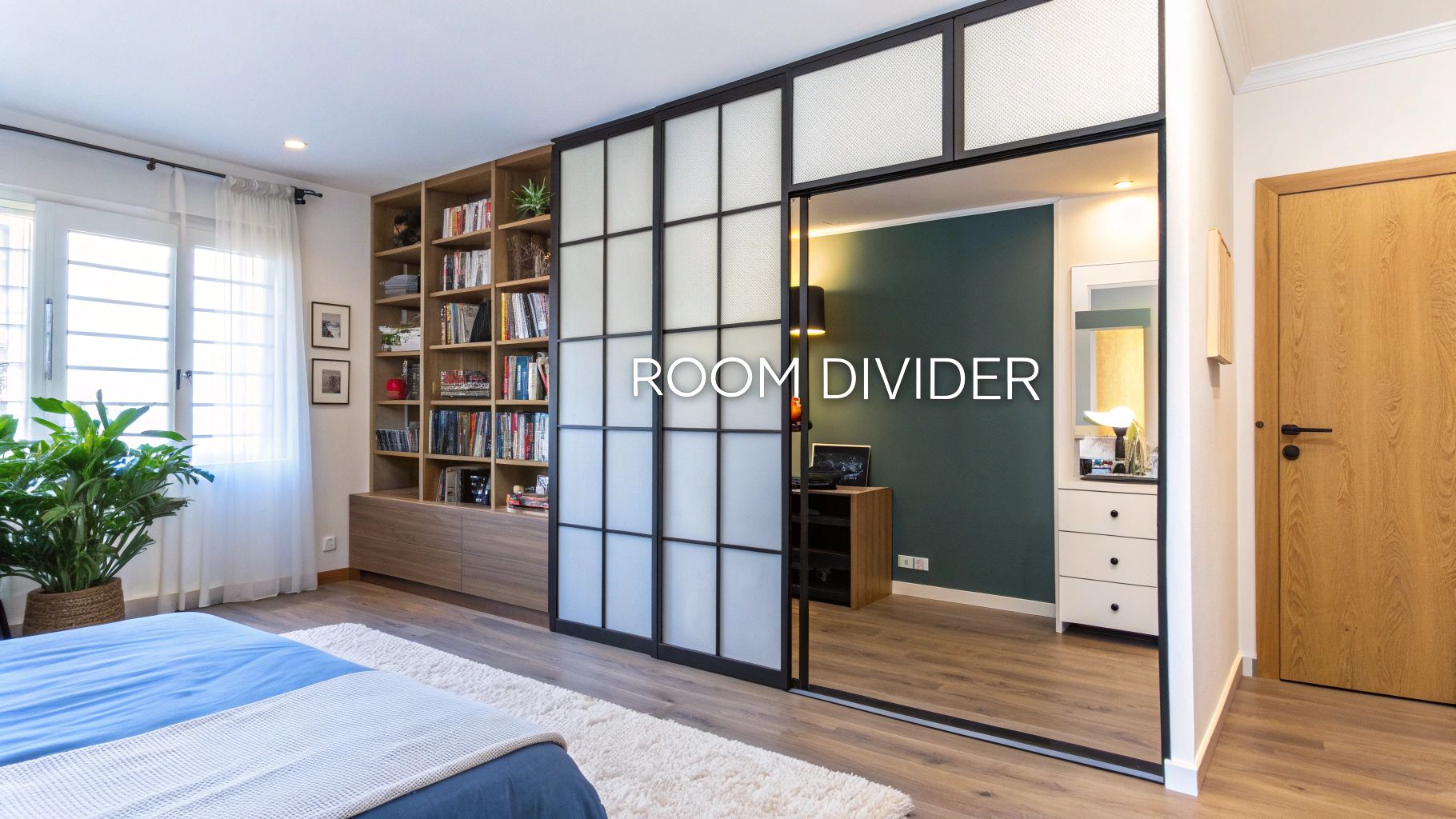Do you dream of a peaceful, organized space that helps you think clearly and feel inspired? For entrepreneurs, bloggers, and content creators working from home, a small apartment can quickly become overwhelming. But what if you could turn your compact space into an advantage?
Minimalist living is more than just getting rid of excess stuff – it’s a thoughtful approach to design that can transform your small apartment into a productive sanctuary. From the clean lines of mid-century minimalism to today’s focus on digital simplicity, the key principles remain constant: be intentional, prioritize function, and keep only what truly matters.

This approach works because it tackles the real issue – having too much stuff that clouds both your space and your mind. When you carefully choose what to keep and optimize your layout, you create room to breathe and think. This mental clarity is essential whether you’re building a business, creating content, or simply relaxing at home.
Over the next few sections, we’ll explore 8 key strategies to make your small apartment both beautiful and functional. You’ll learn practical ways to:
- Maximize every square foot
- Create a sense of calm
- Boost your productivity
- Design a space that reflects your personal style
Let’s discover how to unlock the full potential of your compact home through the power of minimalist design.
1. Multi-functional Furniture
Living in a small apartment means getting creative with space. That’s where multi-functional furniture becomes your best friend. Picture a desk that doubles as your dining table, or a cozy sofa with hidden storage underneath. These smart pieces make small spaces work harder while still looking great.
These versatile pieces are perfect for anyone wanting to maximize their space – whether you’re a content creator needing a flexible workspace or someone seeking a tidier, more organized home. With convertible designs and hidden storage, you can adapt your space to suit different needs throughout the day. A clutter-free environment helps create mental clarity too! You might be interested in: 12 Universal Benefits of Minimalism.
Several companies have mastered the art of space-saving furniture. Resource Furniture makes wall beds with built-in desks that let you switch from bedroom to office in seconds. Ori Systems creates robotic furniture that transforms on demand. Even IKEA’s popular MALM storage bed shows how multi-functional furniture has gone mainstream. Expand Furniture offers clever expanding tables – perfect when you need extra dining space for guests.
As more people move to cities and live in smaller spaces, multi-functional furniture keeps getting more popular. The rise of minimalism has also pushed this trend forward, as people look to own less while doing more with what they have.
Pros:
- Makes the most of limited space: Every square foot works harder
- Reduces furniture needs: Own less but do more
- Saves money over time: Buy one piece instead of several
- Adjusts to changing needs: Reconfigure as needed
Cons:
- Costs more upfront: Quality pieces require investment
- Needs regular upkeep: Moving parts require maintenance
- Can be heavy: Some pieces are challenging to move
- May compromise comfort: Dedicated pieces can be more comfortable
Tips for Success:
- Choose quality hardware: Invest in pieces with sturdy mechanisms
- Check measurements twice: Ensure pieces fit in all configurations
- Test the transitions: Make sure transformations are smooth and easy
- Focus on your needs: Pick pieces that serve your most common activities
Multi-functional furniture is essential for small space living. It helps you maximize space, reduce clutter, and create a more purposeful home. Choose pieces thoughtfully and you can turn even the smallest apartment into a versatile, comfortable space that works for you.
2. Vertical Storage Solutions
When living in a small apartment, making the most of every inch matters. Vertical storage helps you maximize space while keeping a clean, organized look. This approach works great for entrepreneurs, content creators, and anyone who needs a tidy space to stay focused and productive.

The key is using your walls wisely with mounted storage, floating shelves, and tall organization units. You can mix and match different storage options to create a custom setup that fits your needs – whether for books, clothes, office supplies, or other items.
Features and Benefits:
- Wall-mounted storage: Opens up floor space for a more spacious feel
- Adjustable systems: Easy to modify as your needs change
- Space-efficient: Stores more items without taking up precious floor area
- Versatile options: Works for storing everything from books to electronics
Pros:
- Makes use of empty wall space to boost storage capacity
- Adds style and visual interest to your apartment
- Keeps floors clear and rooms feeling open
- Can be customized to fit your exact needs
Cons:
- Requires mounting to walls – may need DIY skills or professional help
- Some rentals restrict wall modifications – check with your landlord first
- Too much wall storage can make rooms feel cramped
- May need a step stool to reach high storage spots
Popular Storage Systems:
The Container Store’s Elfa system offers durable, customizable solutions. The IKEA BILLY bookcase with height extension provides affordable vertical storage. For a sleek modular option, String Furniture systems offer flexible configurations.
Growing Popularity:
Vertical storage has taken off thanks to organizing experts like Marie Kondo and the rise of minimalism. As more people aim to declutter and simplify, vertical storage provides both function and style. Major retailers now offer many great options to help maximize small spaces.
Tips for Getting Started:
- Plan your full wall: Map out storage from floor to ceiling
- Balance open and closed storage: Mix visible displays with hidden storage
- Check wall strength: Ensure walls can support your chosen system
- Leave some empty space: Don’t overcrowd – maintain visual breathing room
For more tips on simplifying your space, check out How to Start Minimalism. Vertical storage is a smart solution for any small apartment, helping you stay organized while making the most of limited square footage.
3. Room Divider Concepts
When you live in a small apartment, space matters tremendously. While open layouts offer an airy feel, separating your living, working, and sleeping areas becomes important – especially for people who work from home and need focused spaces. Room dividers offer a smart solution without major renovations.
Think beyond basic barriers – room dividers are about creating functional zones while maintaining flow. Options like movable screens, translucent panels, or storage units can visually separate areas while keeping spaces connected. They work great as video call backgrounds too, helping create a more organized workspace.
Key Features and Benefits:
- Easy to Move & Adjust: Rearrange your space whenever needed for different activities
- Light-Filtering Options: Keep spaces bright while creating visual boundaries
- Built-in Storage: Many dividers double as shelving or closet space
- Multiple Functions: Some include desks, mirrors, or plant displays
Popular Examples:
- IKEA KALLAX: These versatile shelf units work perfectly as room dividers
- Sliding Panels: Modern solutions for dividing rooms or hiding storage areas
- Floor-to-Ceiling Screens: Simple to install and remove as needed
Growing Popularity
Small space living has made flexible room dividers increasingly common. Japanese design has long used elements like shoji screens to maximize space efficiently. Modern furniture companies now offer many stylish divider options.
Practical Tips:
- Watch the Light: Position dividers to allow natural light flow
- Choose Light Colors: Keep small spaces feeling open and bright
- Add Some Green: Plants make natural, beautiful dividers
- Stay Safe: Ensure dividers are stable, especially with kids or pets
Key Benefits and Drawbacks:
- Benefits: Creates zones, maintains openness, adds storage, flexible setup
- Drawbacks: May reduce light, limits furniture placement, needs careful planning
Room dividers help create purposeful spaces without permanent changes. For more ideas on simplifying your space, check out this guide: How to Start with Minimalism.
This deserves a spot on the minimalist apartment essentials list because it directly helps maximize space and function. For busy professionals and creatives working from home, room dividers provide a smart way to create dedicated areas that support both productivity and relaxation.
4. Minimalist Color Palette: Expanding Your Space with Less
A well-designed minimalist color scheme can truly transform a small apartment. It’s much more than just white walls – it’s a thoughtful approach that creates visual calm and makes spaces feel larger. For anyone working from home, this can make a huge difference in focus and productivity.
The key is starting with a neutral foundation color – whites, grays, or beiges work well as your base. From there, add just 2-3 carefully chosen accent colors to bring in personality without overwhelming the space. You might try different shades of one color for a monochromatic look, or pair contrasting colors for more visual impact. Think soft gray walls with deep teal accents and natural wood tones, or crisp white with touches of black and blush pink.
Why Minimalist Colors Work:
- Makes rooms feel bigger: Using coordinated colors lets your eye move smoothly across the space without visual interruptions
- Creates a peaceful vibe: The simplified palette helps create a calming atmosphere – perfect for work or relaxation
- Easy to update: With fewer colors in play, you can refresh the look with new accessories without clashing
- Reduces visual noise: A simpler color scheme naturally creates a more organized, distraction-free environment
Common Challenges:
- Can feel stark: Without proper planning, minimalist spaces might seem cold. Add textural elements to warm things up
- Takes planning: Test colors thoroughly in your lighting before committing
- Shows wear: Light colors, especially whites, tend to show marks more easily
- Less room for variety: If you love lots of color, this approach might feel too limiting
Design History:
This style draws inspiration from Scandinavian and Japanese design traditions. Think bright Scandinavian interiors that maximize natural light, or serene Japanese spaces that emphasize simplicity. Modern designers like Kelly Hoppen have helped popularize sophisticated monochrome looks, while brands like Muji have brought minimalist aesthetics to mainstream homes.
Practical Tips:
- Follow the 60-30-10 rule: Use 60% dominant color, 30% secondary color, and 10% accent color
- Add texture: Include woven baskets, knit throws, or textured wallpaper to create depth
- Work with light: Choose colors that reflect light well to brighten your space
- Test thoroughly: Paint large swatches and observe them throughout the day before deciding
Want to learn more about using color effectively in your workspace? Check out Design for Success: The Secret of Colors in the Office.
When thoughtfully applied, a minimalist color palette helps create a calm, focused environment that feels more spacious. It’s a proven approach for making small spaces work harder while maintaining visual harmony.
5. Smart Storage Integration
In a small apartment, making the most of every inch matters. Smart storage is not just about cramming things into closets – it’s about thoughtfully using every space while keeping a clean, simple look. For anyone working from home or trying to stay organized in a compact space, good storage makes all the difference between chaos and calm.

When your space is tidy and well-organized, your mind follows suit. Smart storage helps create a peaceful environment where you can focus and be creative. That’s why it’s a must-have for any small apartment setup.
Key Features:
Smart storage includes hidden compartments in furniture, wall-mounted shelving, under-bed storage, and clever corner solutions. The benefits are clear:
- Makes Use of Dead Space: From overhead areas to under-stair nooks, smart storage puts every inch to work
- Keeps Things Tidy: Hidden storage maintains a clean look by keeping items out of sight
- Adapts to Your Needs: Solutions can fit your specific storage needs, whether for office supplies or hobby materials
- Reduces Visual Clutter: Especially helpful for maintaining focus and productivity
Real Examples:
- Under-Stair Storage: Convert unused stair space into drawers, shelves or a mini workspace
- Bed Storage Systems: Platform beds with built-in drawers maximize bedroom storage
- Vertical Pantry Solutions: Slim pull-out shelves make narrow spaces super functional
How Storage Has Changed:
As more people embrace minimalism and small-space living, storage solutions have gotten smarter. California Closets helped pioneer custom storage, while The Home Edit made beautiful organization mainstream. IKEA has brought clever storage options to the masses with affordable, modular pieces.
Pros and Cons:
| Pros | Cons |
|---|---|
| Maximizes unused space | Can be expensive to implement |
| Maintains clean aesthetics | May require professional installation |
| Customizable to needs | Reduced flexibility for changes |
| Reduces visible clutter | Potential accessibility issues (for some designs) |
Practical Tips:
- Plan Storage Needs: Make a list of what needs storing and how often you’ll need access
- Consider Access Frequency: Keep everyday items within easy reach
- Use Drawer Dividers: Keep drawers tidy with proper organizers
- Label Everything: Clear labels prevent items from getting lost in storage
With smart storage solutions, you can turn even the smallest apartment into an organized, peaceful space that helps you be your most productive and creative self.
6. Micro-Kitchen Design
Want to make the most of your small apartment kitchen? A micro-kitchen setup could be your perfect solution. These carefully planned kitchens pack full functionality into minimal square footage, perfect for those embracing minimalist living in compact spaces.

Small space living is on the rise, especially in urban areas where square footage comes at a premium. A well-designed micro-kitchen helps create an organized, clutter-free environment that reduces stress and boosts productivity – essential for anyone living in a small space.
Key Elements of Micro-Kitchens:
Smart design makes micro-kitchens work efficiently. Think ceiling-high cabinets, pull-out cutting boards that tuck away when not in use, and countertops that do double duty as prep and dining surfaces. Space-saving appliances like slim dishwashers and combo microwave-ovens help maximize every inch.
Inspiration from Around the World:
European apartment kitchens show how to pack great function into small footprints. Japanese homes display masterful space efficiency and organization. And tiny NYC apartments prove you can create amazing kitchens in the smallest spaces – with features like fold-down tables, hidden cooktops, and ultra-optimized storage under sinks.
Why Micro-Kitchens Are Growing:
The rise of micro-kitchens connects to several trends: more people choosing minimalist lifestyles, growing interest in tiny homes, and better compact appliances hitting the market. Both European and Asian manufacturers have helped drive innovations in small-space kitchen design.
Benefits and Challenges:
Key Benefits:
- More Usable Space: Free up floor area for other purposes
- Lower Energy Use: Smaller appliances typically use less power
- Better Organization: Limited space encourages smart storage habits
- Budget-Friendly: Can cost less due to smaller appliances and materials
Main Challenges:
- Limited Counter Space: Requires creative solutions for prep areas
- Fewer Appliance Options: May need to compromise on certain features
- Storage Constraints: Smart organization becomes essential
- Single-Cook Space: Usually works best with one person cooking
Tips for Your Micro-Kitchen:
- Pick Key Features: Focus on what you use most often
- Use Wall Space: Install magnetic strips for knives and tools
- Overhead Storage: Mount pot racks to free cabinets
- Multi-Use Tools: Choose appliances that serve multiple purposes
These smart design principles can help transform even the tiniest kitchen into a highly functional space that supports your minimalist lifestyle. It’s about making every inch count while keeping things simple and practical.
7. Light Optimization: Open Up Your Small Apartment with the Power of Illumination
A small apartment can feel spacious and welcoming when you master the art of lighting. The right lighting approach transforms tight quarters into a bright, airy space that boosts both mood and productivity. This is especially important if you work from home – proper lighting helps you stay focused and prevents that cramped feeling.
The principles come from Scandinavian design, which puts a strong emphasis on maximizing natural light. Modern lighting companies like Philips Hue have built on this with smart lighting systems that give you even more control over your space.
Key Ways to Optimize Light:
- Strategic Mirror Placement: Large mirrors, especially floor-to-ceiling ones, bounce natural light around and create visual depth
- Light-Reflecting Surfaces: Choose light colors for paint, furniture and decor – think white cabinets, light wood, and metallic touches
- Smart Window Treatments: Use sheer curtains or blinds that let light in while maintaining privacy
- Layered Light Sources: Mix overhead lights, task lighting, and accent lights to control both function and mood
Benefits:
- Makes rooms feel bigger and more open
- Boosts mood and energy levels naturally
- Cuts electricity costs by maximizing daylight
- Adds visual interest through light and shadow
Potential Challenges:
- Screen glare from poorly placed mirrors
- Finding the right balance of light and privacy
- Higher upfront costs for quality fixtures
- More frequent cleaning of light surfaces
Real Examples:
Picture a tiny studio with just one window. Adding a large mirror on the opposite wall instantly brightens the whole space by reflecting natural light deeper into the room. Glass room dividers let light flow freely while still defining separate areas. Studies consistently show how key proper lighting is in small Scandinavian homes.
Simple Tips:
- Mix different light sources instead of relying only on overhead lights
- Paint walls near windows in light colors to maximize reflection
- Keep windows clear – avoid blocking natural light
- Choose warm lights (2700-3000K) for ambiance and cool lights (5000-6500K) for tasks
Light optimization is essential in a minimalist small space. It helps create a home that feels open, bright and energizing – perfect for anyone who needs to stay productive and focused while working there. With these basic lighting principles, you can transform even the smallest apartment into an inviting sanctuary.
8. Minimalist Decluttering System
Living in a small apartment means being thoughtful about every item you own. A minimalist decluttering approach is more than just organizing – it’s a complete shift in how you think about your space and possessions. This makes it perfect for entrepreneurs with ADD, solo business owners, and content creators who want to create an environment that supports their best work.
Here are the key elements that make this system work:
- One-in-one-out rule: When you bring something new home, an existing item has to go. This prevents stuff from piling up and helps you shop more intentionally.
- Regular review schedule: Block off time each month or season to go through your belongings and prevent clutter from sneaking back in.
- Category-based sorting: Work through items by type (clothes, books, etc.) to stay focused and make better decisions about what to keep.
- Digital solutions: Switch to digital documents, ebooks, and cloud storage where possible to cut down on physical items while keeping everything you need easily accessible.
The benefits are real and immediate: less stress, more usable space, easier cleaning, and money saved by avoiding impulse buys. Picture your small apartment transformed into a peaceful, efficient workspace without visual distractions – especially helpful for those with ADD who do their best work in organized spaces.
Starting a minimalist system does take effort and can feel emotionally challenging at first. The initial time investment might seem overwhelming, and some people find the restrictions difficult as they begin embracing minimalist ideas.
Here are some proven approaches to try:
- KonMari Method: Marie Kondo’s famous approach focuses on keeping items that “spark joy.”
- Capsule wardrobe: Build a small collection of versatile clothing pieces that mix and match well. For example, Project 333 challenges you to dress with just 33 items for 3 months.
- Digital organization: Scan important papers and store them electronically to free up physical space.
Practical Tips to Get Started:
- Begin with visible areas: Tackle spaces you see daily first – quick wins will keep you motivated.
- Pick specific declutter days: Regular sessions make the process manageable.
- Use clear storage: See what you have at a glance.
- Keep a digital inventory: Track what you own to avoid duplicates.
For more specific advice, check out: How to Declutter Your Bedroom: The Ultimate Guide to Creating Your Perfect Sleep Sanctuary
This approach has gained huge popularity thanks to experts like Marie Kondo and The Minimalists showing how decluttering improves wellbeing and productivity. When you stick with it, this system helps transform a cramped apartment into an efficient, peaceful space – making it essential for entrepreneurs and creators who want to do their best work.
8-Point Minimalist Apartment Design Comparison
| Design Tip | Implementation Complexity (🔄) | Resource Requirements (⚡) | Expected Outcomes (📊) | Key Advantages (⭐) | Tips (💡) |
|---|---|---|---|---|---|
| Multi-functional Furniture | Medium – moving parts and transformation | Moderate-High – higher initial cost but cost-effective long-term | Maximizes space utilization and adaptability | Space-saving and versatile | Prioritize quality mechanisms; measure spaces carefully |
| Vertical Storage Solutions | Moderate – requires wall mounting | Moderate – specialized hardware installation | Frees up floor space and adds visual interest | Customizable and clear design | Plan from floor to ceiling; consider wall weight limits |
| Room Divider Concepts | Moderate – flexible setup and placement | Low-to-Moderate – depends on chosen design | Creates distinct zones while maintaining overall flow | Flexible with added storage options | Consider light flow; ensure stability and safety |
| Minimalist Color Palette | Low – simple color re-scheme | Low-to-Moderate – mainly paint or textiles | Enhances visual harmony and spacious feel | Timeless aesthetic and clutter reduction | Use the 60-30-10 color rule; test colors in various lighting conditions |
| Smart Storage Integration | High – custom built-ins and hidden systems | High – may need professional installation | Maximizes storage capacity while keeping a clean look | Discreet, highly customizable storage | Map out your storage needs; label hidden compartments |
| Micro-Kitchen Design | Moderate – careful layout planning required | Moderate – investment in compact appliances | Boosts space efficiency and promotes better organization | Efficient utilization of minimal space | Prioritize key functions; use multi-function appliances |
| Light Optimization | Low-to-Moderate – adding mirrors and fixtures | Moderate – quality lighting can be costly | Creates an illusion of larger space and improves ambiance | Enhances mood and energy efficiency | Layer different light sources; keep windows unobstructed |
| Minimalist Decluttering System | Low-to-Moderate – requires regular maintenance | Low – mainly organizational changes | Reduces stress and simplifies cleaning | Improved space utilization and stress reduction | Set regular decluttering days; document your inventory |
Embrace the Minimalist Small Apartment Lifestyle
A small apartment with minimalist design isn’t about giving up comfort – it’s about being intentional with your space. When you bring together smart storage solutions, multi-functional furniture, vertical organization and a clean color scheme, you create a calming home that feels both spacious and productive. At its core, minimalist living helps you cut through clutter to focus on what matters most, whether that’s growing your business or simply enjoying a peaceful evening at home.
Start your minimalist journey one small step at a time. Pick a single area like your desk or kitchen to declutter first. As you experience how good it feels to simplify that space, you’ll be inspired to tackle other areas too. Remember to adapt these ideas to match your personality and needs – minimalism looks different for everyone.
Small space living continues to evolve with new possibilities through smart home technology. Voice control for storage and lighting, automated organization tools, and AI features are making it easier than ever to customize and optimize compact homes. The future of minimalist apartments is about creating highly personalized, efficient spaces.
Key Takeaways:
- Prioritize Function: Choose items based on their usefulness and purpose.
- Embrace Vertical Space: Think upwards to maximize storage in a small footprint.
- Light is Key: Bright, natural light creates the illusion of more space.
- Declutter Regularly: Regular purging prevents clutter from building up.
- Personalize Your Minimalism: Adapt these principles to fit your individual needs and style.
The Cheat‑Sheet Table
| Tactic | Effort 🔄 | Cost ⚡ | Payoff 📈 | Keep in Mind 💡 |
|---|---|---|---|---|
| Multi‑Functional Furniture | Medium | $$‑$$$ | Frees square footage | Quality hinges matter |
| Vertical Storage | Low‑Med | $‑$$ | Clears floor, adds height | Don’t over‑crowd |
| Room Dividers | Low | $‑$$ | Zones without walls | Preserve light flow |
| Minimalist Palette | Low | $ | Optical spaciousness | Inject texture |
| Smart Storage | High | $$‑$$$ | Hides clutter, sanity boost | Label everything |
| Micro‑Kitchen | Med | $$ | Culinary efficiency | Choose multi‑use appliances |
| Light Optimization | Low‑Med | $‑$$ | Mood & energy bump | Avoid mirror glare |
| Declutter Loop | Ongoing | $0 | Sustained clarity | Schedule it, or lose it |
Are you trying to manage both a growing business and a small living space while dealing with ADD? Lorelei Web offers practical advice to help you create order in your physical and digital worlds, boost productivity, and gain clarity. From minimalist living tips to content marketing strategies, Lorelei shares real experiences and actionable steps to help you focus on what matters most. Visit Lorelei Web today to start creating a simpler, more organized life and business.

Lorelei has been an online entrepreneur, marketer and writer since 2006. Her biggest passion is WordPress, which is why she switched to being a full-time blogger 20 years ago and hasn’t looked back since. With so many years of experience behind her, she is an expert in copywriting, SEO, marketing and business strategies.





